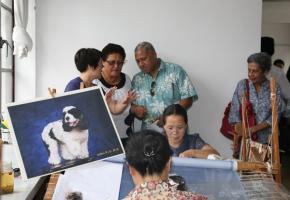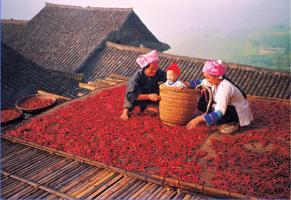Chinese Shadow Play
Chinese shadow puppet show (play), also called Piying Show or Piying Xi in Chinese language, is a traditional folk art, the origin of which can be traced back to the Western Han Dynasty (206BC - 25 AD). With puppet silhouettes made out of cow's leather or donkey hide, the shadow show figures of the Guanzhong area of Shaanxi Province are the most representative in China, which are modeled on the stone relief patterns of the Han Dynasty, the academic-style painting of the Song Dynasty (960-1279AD) and folk paper-cuts. Today, Guanzhong shadow play figures are very popular with collectors and as home decorations. And most tourists who visit Xian, Shaanxi are always willing to buy them as souvenir.
Shadow PlayHistory of Shadow Puppet Silhouettes
More than 2,000 years ago, a favorite concubine of Wu Emperor of the Han Dynasty died of illness; the emperor missed her so much that he lost his desire to reign. One day, a minister happened to see children playing whit dolls where the shadows on the floor were vivid. Inspired by this scene, the smart minister hit upon an idea. He made a cotton puppet of the concubine and painted it. As night fell, he invited the emperor to watch a rear-illuminated puppet show behind a curtain. The emperor was delighted and tool to it from then on. This story recorded in the ancient books is believed to the origin of shadow puppetry.
Shadow puppet silhouettes were first made of paper sculpture, later from the hides of konkeys or oxen. That's why the Chinese name for shadow puppet silhouette is "pi ying", which means shadows of hides or leather. Shadow puppetry was very popular during the Tang and Song dynasties in many parts of China.
Shadow PlayThe Process of Making Shadow Puppet Silhouette Figures
Regular shadow figure head is a full profile, known as "half face". Clown and villain sometimes are given half profile, called "70% face"; fairies and Buddha are shown with a full face. Shadow figure's body is mostly 70%. Carving of shadow figures is vey particular. It requires using knife with ease and making turns smoothly. The hollowed - out facial outline, in particular, requires an exceptional skill in craftsmanship, making lines as thin as "stretching wires," sharp and translucent. Body figure using chisel engraving has a variety of designs, including snow flake, character "王" shape, wealth and fortune, wintersweet, fish scale, pine needle and star eyes, etc. Leather silhouette coloring is usually bright and transparent, mostly in black, red, yellow, and green. Music accompaniments are four string and south string instrument, bowed instrument, four-string moon-shaped instrument, drum, gong, flute, hand allegro and horn. Based on geographical localities, each place has its own unique style and characteristics in shadow figure design, music and instrument.
Shadow PlayFeatures of the Shadow Puppet Show
To overcome the limit imposed when only the profile of puppets can be seen, shadow puppets use exaggeration and heavy dramatization. The faces and the costumes of puppets are vivid and humorous. The flowery color, the elegant sculpting and smooth lines make shadow puppets not only props but also artwork. A shadow puppet takes as many as 24 procedures and more than 3,000 cuts.
The figures of the shadow puppet show are from the Chinese myths, legends and stories even the classical books. And their designs follow the traditional moral evaluation and aesthetics. The audience can tell a figure's character by seeing his mask. Like the masks in Beijing Opera, a red mask represents uprightness, a black mask, fidelity, and a white one, treachery. Shadow PlayThe positive figure has long narrow eyes, a small mouth and a straight bridge of nose, while the negative one has small eyes, a protruding forehead and sagging mouth. The clown has a circle around his eyes, projecting a humorous and frivolous air even before he performs any act.
Modern Situation of the Traditional Leather Silhouette of China
The rapid development of modern economy in urban and rural areas, coupled with the growing influence of television and film culture, traditional leather silhouette is almost precipitation into distinction nationwide except in a few regions in eastern Gansu, Shaanxi and Liaoning Province. Now only some 200 leather silhouette troupes are still around, down from over 1,000 nationwide in the 1980s.

 Accessible China Tours
Accessible China Tours China Ethnic Minority Tours
China Ethnic Minority Tours.jpg) China Biking & Cycling Tours
China Biking & Cycling Tours 

